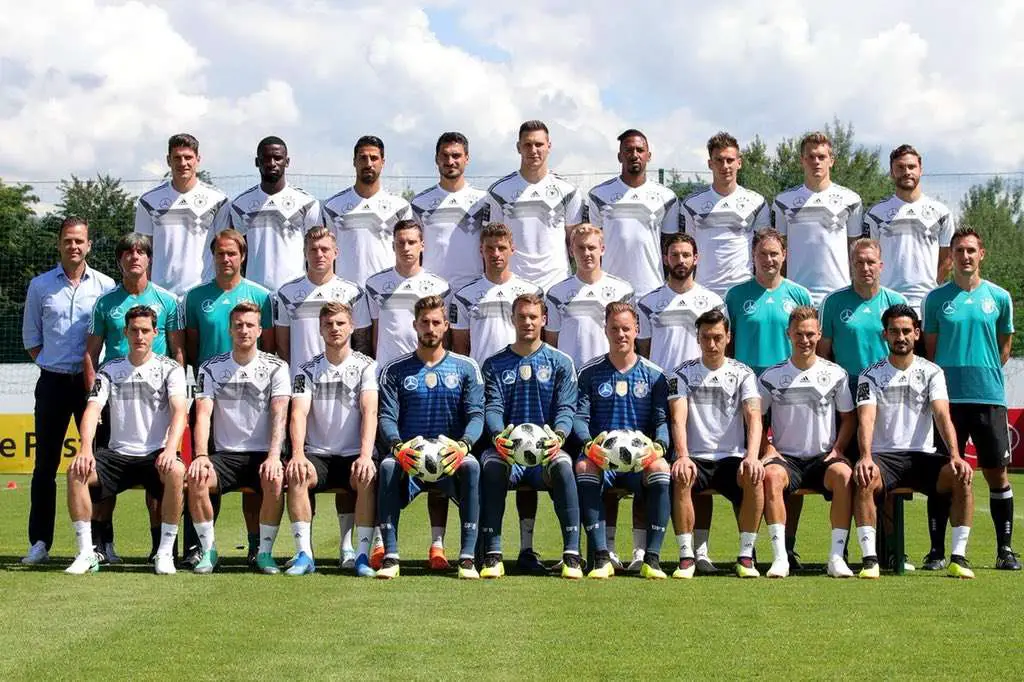When Jogi Löw announced the final squad this Monday, there were a few changes to the provisional, as often is. Manchester City’s Leroy Sané was cut in an act that has been called scandalous by many outside of Germany while it does of course beg the question of how Löw will field his squad this summer.
Many have wondered, pondered and considered, but few really know.
The German goalkeeping situation is something like out of a book. If that book is called “Dictionary” and the word you’ve looked up is “Luxury problem”, that is. This rather nice situation is the purest of definitions of the term, but it does also create a few minor problems.
The lack of clarity from the staff and from the players themselves could create a problematic atmosphere within the German camp. With fit again Manuel Neuer in the side despite little competitive football for Bayern Munich, many have called for Barcelona’s Marc-André ter Stegen to start.
One of the best goalkeepers in the world, Ter Stegen would probably start for every national team in the world. His season has been more than worthy of a starting place in the World Cup. However, the German football sphere is an enigmatic and elitist one where trust is the most important virtue.
Another problem that arises from the goalkeeping situation is: What happens if Neuer doesn’t do well? What happens if his foot doesn’t hold? Ter Stegen will be happy to take his place, but will his mental state be as good as it can be? Probably not. Therefore, it’s a risk to play Neuer from the start, but it’s a risk the Löw surely considers taking.
The defence is not the most exciting regarding news and scandals. Jonathan Tah was excluded, albeit that wasn’t too surprising. Mats Hummels and Jerome Boateng should and will play together with Niklas Süle and Antonio Rüdiger as back-up. A central defence flooded by excellence.
The full-backs shouldn’t bear any surprises. Joshua Kimmich will do what he does best: bomb forward to overload the right flank. Jonas Hector or Mr. Reliable as a newspaper in Cologne once called him, will do what he always does: everything. It’s a simple defence and they will most certainly play the same way they did in the qualifiers and Kimmich will therefore play a key role.
Central midfield will be more interesting. Toni Kroos is an obvious choice, but the question remains as to who will start alongside him. In the past we’ve seen Sami Khedira often play in the double-pivot role, but perhaps Leon Goretzka would be a better choice.
The double-pivot is a key area for Löw. He can unlock different sides of Kroos by utilising different kinds of players alongside him, which is another testament to the immense depth of the squad the Germans do possess.
A more defensive Khedira would work fine in order to utilise Kroos’ brilliance in attack where he tends to be extremely important with his spreading of passes. However, Goretzka’s attacking qualities could also be used and would unlock Kroos’ defensive assets, attributes that tend to be underrated by many.
Sebastian Rudy and Ilkay Gündogan are the last two central defenders in the squad and they have their own strengths. Rudy is the B-version of Toni Kroos, but Gündogan could very well work alongside Kroos. His hard work and his technical abilities would be a good compliment to Kroos’ slow, but efficient brilliance.
Attacking midfield should be occupied by Mesut Özil. The Arsenal man’s presence in the starting XI is key to Germany’s attacking spirit. His excellent vision, grand heart for the unlocking of tight defences and extremely underrated work rate will become key in Löw’s pressing side. His passing and technical ability will also prove valuable when overloading.
He can lure his opposition into traps and has the ability needed to subsequently expose them. Goretzka or Marco Reus will most certainly be his back-up in the squad, albeit Julian Brandt and Julian Draxler could do that job quite well too.
On either side of Özil we’re likely to see Thomas Müller and Marco Reus with Timo Werner leading the line. Löw could also play Müller up top, with Reus and Draxler/Brandt on the flanks which will certainly have teams guessing.
Another option would be to for Werner to shift to the flank while Mario Gomez could play up top with Julian Brandt on the other flank. The opportunities are endless with this flexible and versatile attack. One of the keys with Löw’s system is the versatility of his players. They need to be able to occupy different roles and positions on the pitch and this flexibility is the main theme in his choice of players.
We also saw the biggest surprise yet last Monday as Löw left the brilliant and erratic Sané out of the squad. This move has been called ‘controversial’, ‘not too controversial’, ‘surprising’ and ‘not that surprising’ by journalists.
Consider it to be another example of Löw being brutal. Of course, Leroy Sané has potential to become something special, but the World Cup is not there to promote youngsters. Sané has had a fantastic season at Manchester City, that is true. However, Brandt has had a similar season at Leverkusen where he’s taken lots of responsibility on and off the pitch.
Löw has a fetish for attitude on and off the pitch. He clearly has seen problems with Sané’s ego, something that Brandt doesn’t even possess, and thus chose Brandt instead. The Leverkusen man is much more versatile and flexible as well and therefore fits Löw’s plan for the team better.
4-2-3-1 would in no way be unexpected for the Germans. It could be a good summer for a German team with perhaps the best squad they’ve had in many years and it’s potentially a team that could go on and retain their World crown.
By Axel Falk.










